





A symbol of love, peace, hope and longevity, the Maidenhair Tree has withstood the Ice Age and the bombings in Japan in WWII. It is an amazing testament to endurance and strength and lives on as a survivor with healing capabilities.
Fossils found of leaves related to the modern Ginkgo date back some 270 million years. What we today call Ginkgo biloba include the only two known species of the tree in fossil form, G. adiantoide and G. gardneri. Having survived the Ice Age, its only living descendents were found in a small area of central China. Thus, having no close living relatives, it is uniquely and singly placed in its own family and genus being the only extant species in its group. This fact alone has made the mass plantings of Ginkgos paramount to forestalling its extinction. Surviving Ginkgo trees have been cared for and preserved by Chinese monks for over a thousand years.
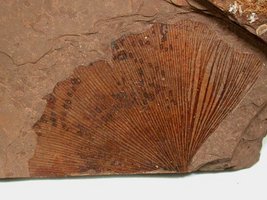
The Chinese name for this tree is yínguo (silver fruit) and yinxing (silver apricot or white fruit) and was translated into Japanese as ichō, pronounced as ginkyo. It was later misspelled as ginkgo by the first westerner to see and record this species in 1690 and that is the name we use today although it is often misspelled as gingko.
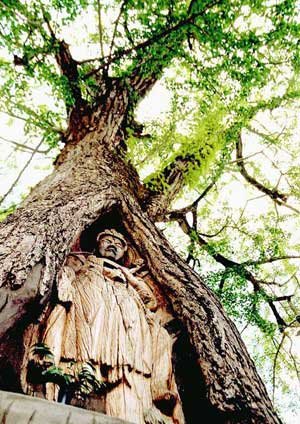
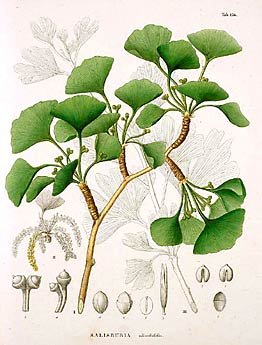
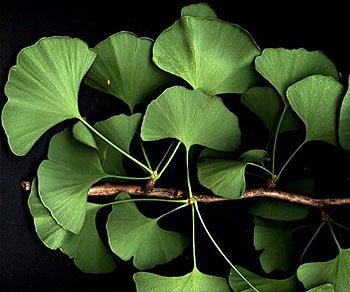
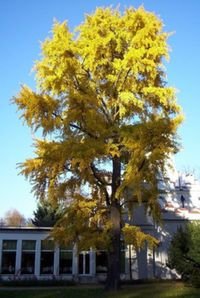
Maidenhair Trees grow very tall, change colors in autumn and some of the oldest in China are reported at 164 feet tall. They have separate sexes with the female tree producing the seeds and nuts and being the more attractive of the two growing more round and fuller. However, the male tree is usually the tree of choice because the outer layer of the seeds contain an irritating acid and its’ scent is said to resemble the smell of rancid butter.
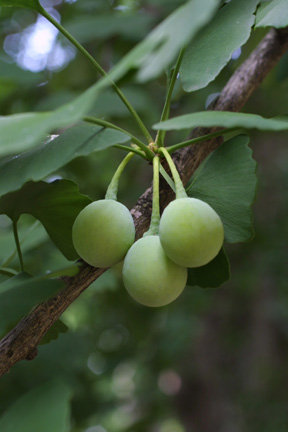
It is a very hardy tree and grows in poor soil in the worst conditions. A popular urban tree planted along many streets as shade trees, they withstand harsh conditions and rarely suffer from diesese. Its wood is insect resistant which makes it a long lived specimen. A 3,000 year old tree lives in Shangdon, China and the remains of these trees still live in Japan after the WWII bombings . When the lands were descimated these trees still stood, scarred but alive. It was doubtful that anything would grow here again but Ginkgo resprouted the following spring and the bark has since been thought of as fire proof making the tree known as a symbol of longevity, peace, and hope.
Its unique leaf shape has been used in art as a symbol all over the world. Yoko Ono’s “Wish Tree” planted in memory of John Lennon is a Ginkgo. A stately specimen graces the home of Frank Lloyd Wright and it is widely used on college and university campuses as a symbol of wisdom. 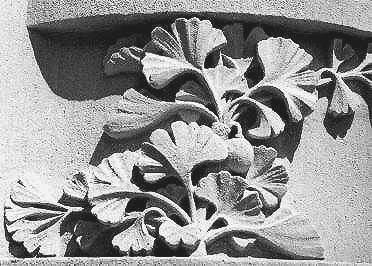
What Charles Darwin referred to as a “living fossil” has been a part of Chinese medicine for centuries where its nuts were once used for currency. The nuts inside the seed pods are also a traditional asian food served at weddings and festivals and can be bought in cans at asian stores as “White Nuts”. In addition to being an aphrodisiac, the leaves contain flavonoids and terpenoids, and in ancient times the bark, the leaves and the seeds of the Ginkgo tree were used to cure various disorders such as wounds and inflammations, vertigo, to strengthen the memory, to ease bronchial troubles and to further the blood circulation and the digestion.
To make a tea use 1-2 teaspoons of dried, chopped, and washed leaves, or 2 tablespoons of fresh, chopped leaves to 250ml boiling water. Place the leaves in a suitable tea infuser or mesh tea ball, put it in a tea pot and add boiling hot water. Steep for 7-8 minutes. Remove the tea infuser or mesh tea ball and, if wanted, add ½ teaspoon honey or maple syrup. Also try adding this infusion to your favorite tea.
 All the amazing qualities of this tree make it a must have for any garden including its beauty, healing properties, maintenance free habits, and preservation of an ancient artifact. Plant your Ginkgo as a symbol of peace and love.
All the amazing qualities of this tree make it a must have for any garden including its beauty, healing properties, maintenance free habits, and preservation of an ancient artifact. Plant your Ginkgo as a symbol of peace and love.
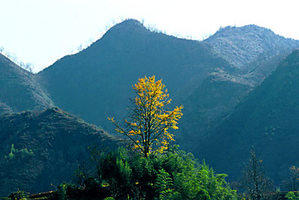
Photos are used by permission of the photographer Cor Kwant from The Ginkgo Pages expressly for use on Dave's Garden.com
This beautiful mountain pic of Ginkgo is used by permission of the talented photographer Jimmy Shen.
(Editor's Note: This article was originally published on November 1, 2007. Your questions and comments are welcome, but please be aware that authors of previously published articles may not be able to promptly respond to new questions or comments.)
Copyright © www.100flowers.win Botanic Garden All Rights Reserved